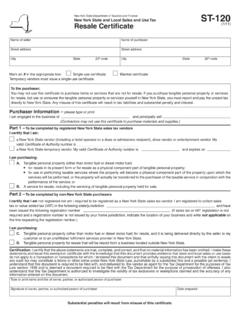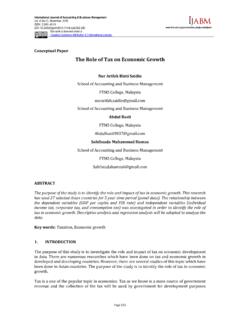Transcription of The VAT Brochure - Skatteverket
1 The VAT Brochure An introduction to VAT. The VAT Brochure is primarily aimed at small and medium-sized enterprises but also for others that need basic information on VAT ( value added Tax). The information is general and should not be r egarded as a legal text on the subject. This Brochure deals with issues faced by most traders. More brochures External trade, cultural activities and voluntary VAT liability when letting or leasing business premises are dealt with in greater detail in separate brochures. T. here are also brochures that describe how to report and pay VAT. and how you submit information before you start a business liable to VAT. Read more at You will find more detailed information about VAT at the Swedish Tax Agency's website , where you can also read or download guides, i nformation leaflets, legal case reports, brochures, forms and other documents. You can also use the Agency's electronic service to submit your VAT returns and EC sales lists/recapitulative statements.
2 VAT rates .. 25 % 12 % 6%. Contents News for January 2016 3. What is VAT?.. 3. Abbreviations and terms 4. When you start a business 5. When must I charge VAT? 7. Reverse charge of VAT 11. When am I entitled to deduct VAT? 14. You must issue an invoice 16. When shall I report and pay VAT? 19. How do I calculate VAT? 23. Reduced VAT rates 26. Exemptions from VAT 28. Special VAT issues 34. What happens if I make a mistake? 38. 2. News for January 2016. VAT for the sale of second-hand goods Increased delay charges for VAT returns Sales of second-hand goods conducted by public non-pro- and periodical recapitulative statements fit organisations and registered religious communities are The delay charges for VAT returns and periodical recapi . exempt from VAT if: tulative statements have been increased. If a VAT return is sales are of donated goods not submitted in time, there is a delay charge of SEK 625.
3 The donated goods are used to finance non-profit If a periodical recapitulative statement is not submitted in work time, there is a delay charge of SEK 1,250. These delay sales are made during a fiscal year starting after 31 charges apply to VAT returns and periodical recapitulative December 2015. statements that are submitted after 1 January 2016. The cessation of slussningsregeln . Slussningsregeln = a provision by which Swedish group Certain post services and companies which are not entitled to deduct input VAT stamps are exempt from VAT. may transfer input VAT to another company within the Post services are exempt from VAT when they are part of same group if the latter is engaged in taxable transactions the universal postal service in accordance with the Postal and can, therefore, deduct input VAT. Services Act. Postage stamps that are used for services The possibility for a group to transfer input VAT from included in the universal postal service are exempt from a tax free organisation to another company within the VAT.
4 However, this exemption does not apply to the uni- group will cease as of 1 January 2016. versal postal services whose conditions have been indivi- dually negotiated. Furthermore, changes have been made to the special rule for the cross-border conveyance of mail Legal persons registered for VAT shall for postal undertakings and the special rule for the place always declare VAT upon import to the of supply of services regarding postal services is removed. Swedish Tax Agency Changes to legislation apply as of 1 April 2016. Imports that are made by legal persons registered for VAT, but do not act on behalf of a taxable person upon the import, shall account for the import VAT in the VAT. return . Changes to legislation regarding imports made as of 1 January 2016. What is VAT? VAT is a tax that we pay on almost all consumption of If you conduct economic activities and sell goods or goods and services.
5 VAT is paid by all consum ers, but services liable to VAT, you must register with the Tax payments directly to the state are made by businesses. Agency. You must also submit tax returns and pay VAT to VAT is not an expense for those who pay it to the state. the Tax Agency. You must pay the differ ence between the While you must pay VAT on your pur chases, in most VAT that you charge on your sales (output VAT) and the cases you are entitled to deduct that same VAT. VAT that you pay on your purchases (input VAT). If you are registered for VAT then you must also account for, and pay, VAT to the Swedish Tax Agency when importing products for your business. 3. Abbreviations and terms Acquisition = Purchase Input VAT = VAT that a trader pays on purchases for the business or himself/herself calculates on pur chases in Adjustment = Adjustment of deductions for input VAT. cases of reverse charge liability.
6 Asset item = Asset intended for permanent use in the Intra-EU acquisition = Purchase of goods from a nother business. EU country when the purchaser pays VAT in Sweden. Business accessories = Equipment or interior fittings in a Invoicing method = The VAT is reported during the property acquired for direct use in a particular business. period when you record cash payments and unpaid invoi- ces. The method requires you to book receivables and Current asset = Asset intended for sale. debts on a continuous basis. Digital services = generic term for e-electronic services, Mixed business = Sales exempt from VAT and liable to telecommunications services and broad casting services. VAT. Economic activity = Production of or trade in goods or Output VAT = VAT that enterprises charge to their custo- services, including agriculture, mining and similar. Also mers and pay to the state. the use of tangible or intellectual property rights to earn a continuous income.
7 Profit Margin Taxation (PMT) = Method of taxation on difference between purchase price and sale price. EC = European Community value added tax area (the name EC has been replaced by EU in accordance with the Reverse charge liability = Reverse VAT liability. Treaty of Lisbon but remains in some of the Swedish Tax Agency's forms and brochures). Reverse VAT liability = Liability to report and pay VAT. transferred to purchaser. Electronic service = Service supplied electronically, often via Internet. Right to deduct = Right to deduct input VAT on purcha- ses or imports for business that entails liability for VAT or EU = The European Union. In the Brochure EU or EU entitlement to a refund of VAT. country means a country or an area that belongs to the European Union value added tax area ( land is for Self-supply = You supply goods or services without pay- example not included). ment, for private use.
8 Export = Sale of goods to a place outside the EU or sale of Service = Something that can be sold other than goods, services outside the EU. a right. Final accounts method = The VAT is reported in the Split financial year = Financial year other than the calen- period when you pay or receive payment but not later than dar year. when preparing final accounts. Taxable person = Legal or natural person independently Foreign taxable person = Taxable person whose economic carrying on economic activity. And also those temporarily activity does not have its registered office or fixed esta- selling new means of transport to another EU country. blishment in Sweden and whose habitual residence is not in Sweden either. Tax rate = Percentage rate for calculation of output VAT. (tax rate x taxable basis = VAT). Foreign trader = A business that does not have its r egistered office or fixed place of establishment in Sweden Tax year = Corresponds to the financial year in the case of and that is not permanently here.
9 VAT reporting. Goods = Material things such as raw materials, semi-finis- Taxable basis = The value on which VAT is calculated. hed and finished consumer or capital goods and property. Also included are gas, heating and cooling, and electricity. Taxable entity = Entity that must pay VAT to the state. Import = Goods brought into Sweden from a place outside Turnover = Sale or self-supply. the EU. VAT- return = value added tax return . VAT registration number = Number given to entities regis- tered for VAT by the Tax Agency. 4. When you start a business Do I have to register for VAT? VAT registration is necessary for you to be able to issue correct invoices with VAT. There are companies whose business does not oblige them to invoice VAT, but which are still entitled to a refund of output VAT. Such compa- nies must be registered in order to receive a refund. You must always register if you are liable to charge VAT, irrespective of the amount of your sales.
10 Your appli- cation should be submitted before you start trading. IN. R. AC. VE. SW. Y. NO. T. LIT. IVI. R. ED. TU. BI. EN. TY. LIA. T. VA. How do I register for VAT? VAT liability requirements, be obliged to charge its Electronically customers VAT. You can use electronic identification on the website 1. There must be a turnover. You turn over (sell) goods to apply for VAT registration and make if you deliver them for payment. A service is sold if it certain other notifications and applications to the authori- is provided for payment. You also sell goods and ser- ties. You can also obtain advice on your enterprise and vices if you self supply them without payment. help in choosing the right corporate form. 2. The turnover must be liable to VAT. The main rule is that turnover of goods and services is liable to VAT, but there are a number of exceptions (see page 10). Tax and payroll tax application form 3.







